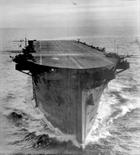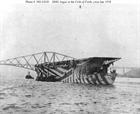On this day 14 September 1918
She was begun as the Italian Liner Conte Rosso in 1914, purchased by the Royal Navy in 1916 and finally completed as HMS Argus in 1918.
HMS Argus was the world's first-ever flush-deck aircraft carrier. Fitted with a full-length flight deck and a hangar capable of accommodating up to 20 aircraft, she was the first large vessel specifically designed and constructed as an aircraft carrier for service with the Fleet. The 'dazzle' camouflage scheme was designed to confuse the enemy as to which way the ship was moving and make it difficult to aim and get a firing resolution. Unlikely though it might sound it worked until radar was invented.
After commissioning, 14 September 1918, the ship was heavily involved for several years in the development of the optimum design for other aircraft carriers. Argus also evaluated various types of arresting gear, general procedures needed to operate a number of aircraft in concert, and fleet tactics. The ship was too top-heavy as originally built and had to be modified to improve her stability, 1925-26. She was put into Reserve in 1929.
Argus was partially modernised shortly before the Second World War and recommissioned 30 July 1938 serving as a training ship for deck-landing practice until June 1940. She ferried Australian and New Zealand personnel to UK in June 1940. For the next two years, she made many ferry trips to and from the Mediterranean and including several to Malta. In June 1942, she participated in Operation Harpoon, providing air cover for the Malta-bound convoy. In November, the ship provided air cover during Operation Torch, the invasion of North Africa during which she was hit by a bomb, and then torpedoed by U-155 on the return to UK. After repairs, Argus was used again for deck-landing practice until late September 1944 and then reclassified as an accommodation ship in December 1944. She was sold for scrap 5 December 1946.




